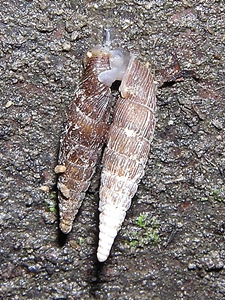
Common door snails (Alinda biplicata) mating.
[RN]
 Common door snails (Alinda biplicata) mating. [RN] |
Contents
Introduction
Distribution
Ecology
Characters
Scientific Importance
Common Door Snail (Alinda biplicata)
Introduced Species
Systematics
Further Information
Literature
![]() Clausiliidae Part
II: Central European Door Snails.
Clausiliidae Part
II: Central European Door Snails.
Door snails are a family of terrestrial pulmonate snails (Stylommatophora) living on tree trunks, walls and rocks, where they can be seen crawling around in humid weather. Their outer appearance differs widely from what is expected of for snails, as door snail shells are not coiled to form a round spiral, but are into a tower-like spire, albeit a very small one – door snails usually are not larger than 20 mm.
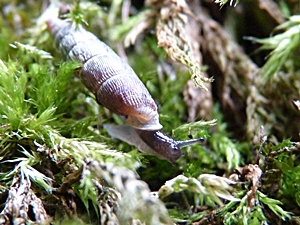 Common door snail (Alinda biplicata). Picture: Martina Eleveld. [See also: Picture by RN on biolib.cz] |
The largest Central European species, the ventricose door snail (Macrogastra ventricosa), is only little smaller than that, with an average shell height of 19 mm. In contrary to that the smallest species, adequately named Clausilia rugosa parvula, has got a shell of averagely 9,5 mm height.
![]() Native Door Snails (Clausiliidae).
Native Door Snails (Clausiliidae).
The largest of all door snail species cannot be found in Europe, it lives in Japan: Megalophaedusa martensi grows to over 4 cm!
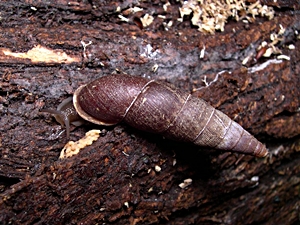 Megalophaedusa martensi from Shizuoka, Japan. Picture: Takahashi, Wikipedia. |
Door snails definitely are distributed in a large number of species in the Palaearctic (see Faunal provinces of the Earth), especially in the south-east of Europe, but actually there are three independent areas of distribution where door snails can be found. Those, apart from the Palaearctic as far east as the Ural mountains and the Yemen, are the north-western mountain regions of South America on one hand and the tropical forests of South and East Asia, Japan and the southern Korean Peninsula on the other.
![]() Schileyko,
A. A. (2000): "Treatise on recent terrestrial pulmonate molluscs". Part 5.
Clausiliidae. - Ruthenica Suppl. 2 (5): 565 - 729.
Schileyko,
A. A. (2000): "Treatise on recent terrestrial pulmonate molluscs". Part 5.
Clausiliidae. - Ruthenica Suppl. 2 (5): 565 - 729.
The distribution of door snails may also happen in spectacular ways: So it has been found out that door snails (Balea perversa) were able to settle on the island of Tristan da Cunha by flying 9000 km from Madeira attached to the feet of birds! Genetic research was able to exclude human interference, as the snails on Tristan da Cunha were to far developed from their ancestors for the introduction to have happened when man sailed to Tristan da Cunha.
![]() Wolfgang
Weitlaner: "The
secret of the flying snail is solved" (Innovationsreport.de, 27. 01.
2006, in German).
Wolfgang
Weitlaner: "The
secret of the flying snail is solved" (Innovationsreport.de, 27. 01.
2006, in German).
In addition to their characteristic form, door snail shells are also set apart from those of most other snails in usually being sinistral or left handed. There are, though, some door snail groups with dextral (right handed) species, among those the Alopiinae. In this subfamily of door snails, there is as well the Alopia genus, native to the Carpathian mountains, as the Albinaria genus, native to the southern Balkan Peninsula. Both have dextral species among their number.
![]() Hartmut Nordsieck:
Dextral Clausiliidae (Gastropoda, Stylommatophora), an evolutionary problem.
Hartmut Nordsieck:
Dextral Clausiliidae (Gastropoda, Stylommatophora), an evolutionary problem.
Door snails feed on algae, which they rasp from the ground using their radula. Like other terrestrial pulmonates they are hermaphrodites. There are, though, some door snails, such as the Central European common door snail (Alinda biplicata), which are ovoviviparous. That means, oviposition is delayed long enough for the young snails to hatch inside the parent's body and to be born alive. Alternatively sometimes also eggs with far developed embryos are laid.
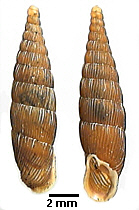 Alinda biplicata. Bild: Helmut Nisters. |
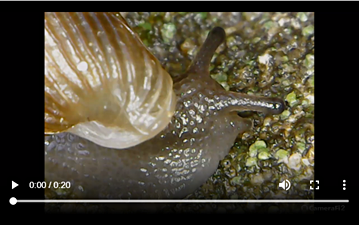 Common door snail (Alinda biplicata) grazing algae on a stone. Videos: Martina Eleveld. |
| "The common door snail still is quite frequent, some other species of the family in Europe are very rare and threatened in their existence. Living in crevices, those creatures live in some very endangered biotopes, such as old walls, isolated rocks and decaying wood. Even in the garden, we can offer living space and protection to those interesting little creatures by not closing each wall crevice with cement and by leaving some stones or old wood to lie in shady garden corners. Apart from door snails, many other species will use those hiding places and so make the garden ecologically more valuable." Source: Mollusc of the year 2010: Die Gemeine Schließmundschnecke (The common door snail), Alinda biplicata (Montagu 1803). |
Externally, many door snail species are hard to tell apart. But enhanced by a magnifying glass or a binocular microscope differences in the surface sculpture of elsewhere similar species reveal themselves. There are, on one hand, species with an almost smooth shell surface, such as Cochlodina laminata. On the other hand there are many of the remaining door snail species, different by a variety of ribs running across the shell whorls. The density and form of those ribs makes it possible to determine different species. In nature this surface of ribs may, however, be hidden under a camouflage of dirt or faeces.
Besides form and sculpture of the shell, also the shell aperture can be used for determination purposes. There are round, oval and even pear shaped apertures among door snails.
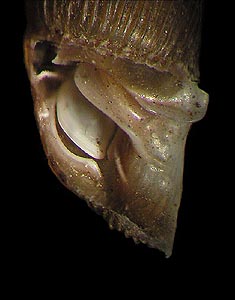 Closing apparatus (Clausiliar) of a common door snail (Alinda biplicata). Picture: Jiří Novák, biolib.cz. |
Looking more closely and with sufficient magnification at a door snail's shell aperture, many species reveal an apertural armature with folds appearing as toothlets to the outside. According to their position, the following major folds are distinguished: The palatal fold is located at the aperture whorl's external wall. On the opposite, columellar wall there is the lower or columellar fold. Above, on the upper wall of the apertural whorl, there is the upper or parietal fold. Finally below the columellar fold there may be an additional subcolumellar fold.
 |
![]() Hartmut Nordsieck:
Clausiliidae
1:
Collection and examination of door snails, as well as the
scientific terms of the closing apparatus necessary for identification.
Hartmut Nordsieck:
Clausiliidae
1:
Collection and examination of door snails, as well as the
scientific terms of the closing apparatus necessary for identification.
Among most door snail species then a plate from calcium carbonate can be discovered, shaped like a spoon the elastic handle of which is connected to the shell spindle (columella). This clausilium is pressed to the shell's outer wall, when the snail is stretched out of the shell and crawling around. As soon as the snail withdraws into its shell, the clausilium swings forward and closes the aperture.
Picture on the right: Clausilium of the door snail Macrogastra plicatula. 1: shell spindle (Columella); 2: Connection of clausiliums and columella; 3: Handle and 4: Plate of the clausilium. Source: Licharev, I. M. (1962): Klauziliidy (Clausiliidae), Fauna SSSR, Molljuski, Bd. 3, T. 4.; after Ehrmann, P.: "Mollusken", 1956.
It is not fully clear, what the determining evolutionary advantage of the clausiliar has been to door snails. It seems highly probable, though, that it means an additional protection against dryness, given door snails' distribution centre around the Balkan peninsula and Asia Minor.
Scientifically door snails are of very high interest to scientists, especially because quite numerous species may occur in a relatively small area. This is because single populations even on single rocks may be separated by dry areas exposed to the sun. Due to this isolation there can be allopatric speciation leading to the development of new species. There is also the possibility of sympatric speciation due to bastardization between closely related species. Especially then, characters of the shell and the composition of the clausiliar apparatus may not be sufficient to determine a species. Then an anatomical examination of the genital apparatus becomes necessary. Facing the distribution of door snail species, which may cover only very small areas, human influence may have a very high importance, as, similar to the situation of endemic island snail populations, changes due to agriculture, road construction etc. can cause sudden unpredictable and irreversible harm.
Common Door Snail - Alinda biplicata (Montagu 1803).
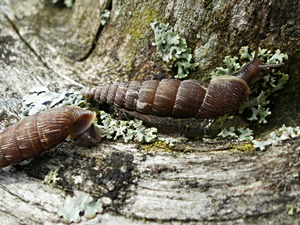 Common door snail (Alinda biplicata). Picture: Sigrid Hof (Source). |
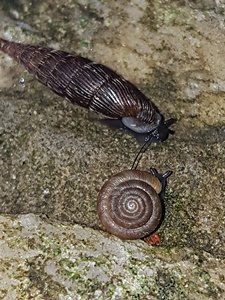 Common door snail (Alinda biplicata) with disc snail (Discus rotundatus). Picture: Martina Eleveld. |
The common door snail is one of the most common door snail species in Central Europe and thus one of the most frequently encountered.
Description: The common door snail's shell is light brown
and relatively large. The shell surface shows clearly visible ribs, which are
emphasized white near the whorl's suture. On the but last whorl, the rib desity
is 5 - 6 ribs per millimetre. The slightly widened aperture lip shows no
folds and the aperture is slightly poited at the lower end with a distinct basal
groove. The lower lamella is simple, the upper parietal lamella is distinctly
visible with a vertical view on the aperture.
![]() .
.
Dimensions: H: 16 - 18 (- 22) mm; W: 3,8 - 4 mm.
![]()
Habitat and Distribution: The common door snail preferrably lives in shadowy, rather humid habitats in forests, in the leaf layer on the ground as well as on fallen logs, in clumps of nettles and other plants, as well as between rocks and on old walls. The snails basically lives on the ground, nut during humid weather it also sometimes climbs the trunks of trees. Common door snails might also be found in cultural areas like gardens and parks, especially if there is an old wall overgrown with algae and lichen. Dwarf forms of Alinda biplicata can be found in warm and dry (xerotherm) places. The species prefers areas with ground rich in lime. The common door snail generally is ovoviviparous, i.e. it gives birth to living young, which eralier hatched in the mother's body. If the environmental conditions are favourable, Alinda biplicata might also lay up to 11 eggs.
The common snail's distribution area spreads over vast parts of Central Europe, from northern France, Belgium and the Netherlands over Germany, Switzerland, Austria, Czechia and Slovakia as far as Hungary, western and Southern Poland, in the southwest as far as Bulgaria. In Britain, Alinda biplicata also occurs in the Thames valley and in eastern Cornwall. Apparently it is domestic there, since fossils have been found from the Holocene era. Though the common door snail also successfully settled in gardens, the natural habitats near water bodies have largely been destroyed due to construction work. In isolated areas, the species also occurs in Denmark, southern Norway and southern Sweden. This might be due to introduction by man.
In Switzerland the common door snail may be found as high as 800 m altitude, in Austria and in Bulgaria as high as 2300 m.
![]() Francisco
Welter-Schultes:
Balea biplicata species homepage.
Francisco
Welter-Schultes:
Balea biplicata species homepage.
![]() Further Central-European species:
Common Door
Snails
(Clausiliidae) Part 2 .
Further Central-European species:
Common Door
Snails
(Clausiliidae) Part 2 .
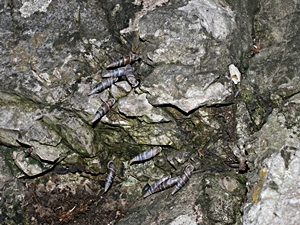 Bosnian door snails (Herilla bosniensis) in their natural habitat in the Klausen gorge near Mödling. Picture: © Alexander Mrkvicka, Vienna (mrkvicka.at). |
 View into the Klausen gorge in Mödling, Lower Austria. Picture: Martina Eleveld. |
Bosnian Door Snail (Herilla bosniensis)
The Bosnian Door Snail (Herilla bosniensis) originally is at home at steep limestone rocks in the Dinaric mountains between Croatia and Northern Albania. Besides, it also appears as an introduced species in an isolated place in Lower Austria, the Klausen gorge near Mödling.
Italian Door Snail (Papillifera bidens)
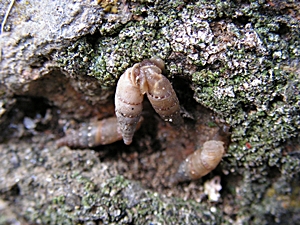 Italian door snails (Papillifera bidens), two specimens mating. Picture: Sigrid Hof (Source). |
Some time ago, near Cliveden House in Berkshire, England, a population of the Italian door snail (Papillifera bidens) had been found, which had reached England in the most astonishing manner:
Obviously the snails had been brought to England with a transport of stones from Italy at the end of the 19th century. All that time they had survived in this area, spreading only to some places nearby.
Another population of the species had been known for a longer time from the small island of Brownsea in Dorset at the English southern coast near Bournemouth. But this population is assumed to have been introduced with rocks brought from Greece in the 1880s. However, it belongs to the same species.
While Britain is on the search for further populations of the species on the British Isles, there is also the discussion how the snail should be called in English: Cliveden snail or Brownsea snail.
The scientists, however, have a similar problem: What should the species' correct scientific name be? The original name Papillifera papillaris had to be dismissed for an older one: Papillifera bidens according to Linné or Linnaeus. The ICZN also decided that way in 2007. There is, however, a publication by Kadolsky (2009) supporting the opinion that this name was not correct either. Kadolsky bases his opinion on the assumption that Linné originally wanted to describe another species which today is called Cochlodina incisa. This door snail species on the other side, resembles Papillifera bidens only vaguely (both being door snails) and the conclusion seems rather far-fetched. For that reason, the German malacologist H. Nordsieck, author of "Worldwide Door Snails, Recent and Fossil", thinks Kadolsky's results to be inconclusive and wrong, and therefore the scientific name Papillifera bidens to be absolutely correct.
![]() More Information about the Italian Door snail.
More Information about the Italian Door snail.
|
|
Richard Black: Snail hides from march of history. | |
|
|
Kadolsky, D. (2009): Turbo bidens Linnaeus 1758 (Gastropoda: Clausiliidae) misidentified for 250 years. – Journal of Conchology, 40 (1): 19-30. | |
|
|
Hartmut Nordsieck: Papillifera bidens (Linné 1758) (Clausiliidae, Alopiinae), a common, but little known species (in print). | |
| Hartmut Nordsieck: Die letzte große Clausilien-Exkursion nach Italien, eine Fahrt der klimatischen Extreme. (in print). | ||
|
|
Sharpe, J. R. (2005): Papillifera papillaris (Gastropoda: Clausiliidae): a new record for Britain. The Archeo+Malacology Group Newsletter, (7): page 6 - 7. (PDF). |
Class:
Gastropoda
![]() Subclass:
Pulmonata
Subclass:
Pulmonata
![]() Superorder:
Eupulmonata
Superorder:
Eupulmonata
![]() Order:
Stylommatophora
Order:
Stylommatophora
![]() Suborder:
Sigmurethra
Suborder:
Sigmurethra
![]() Infraorder:
Clausilioinei
Infraorder:
Clausilioinei
![]() Superfamily:
Clausilioidea
Superfamily:
Clausilioidea
![]() Family:
Clausiliidae Mörch 1864
Family:
Clausiliidae Mörch 1864
![]() Source: Mollbase on
http://www.mollbase.de/list/.
Source: Mollbase on
http://www.mollbase.de/list/.

The
Homepage by Hartmut Nordsieck on Helicoidea, Cochlostoma and Clausiliidae on
hnords.de.